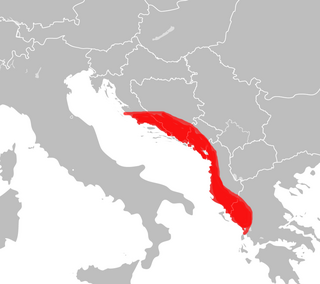
Johann Christoph Friedrich Klug, was a German entomologist. He described the butterflies and some other insects of Upper Egypt and Arabia in Christian Gottfried Ehrenberg and Wilhelm Friedrich Hemprich's Symbolæ Physicæ. He was professor of medicine and entomology in the University of Berlin where he curated the insect collections from 1810 to 1856. At the same time he directed the Botanic Garden in Berlin which contains his collections. Klug worked mainly on Hymenoptera and Coleoptera. The plant genus Klugia was named in his honour as well as the butterflies Geitoneura klugii and Heliophisma klugii.

Euploea klugii, the brown king crow or king crow, is a butterfly from the family Nymphalidae found in India and Southeast Asia. The species was first described by the entomologist Frederic Moore in 1858.

Geitoneura klugii, the common xenica or Klug's xenica, is a species of butterfly belonging to the family Nymphalidae. It is a southern Australian butterfly that is easily camouflaged because of its resemblance to the ground where it is usually found fluttering. It has a wingspan of about 38 millimetres (1.5 in). The upper and lower side of the forewing is black with brownish-black markings and contains a black spot with a white centre. The orange hindwing is set off by a black border and a black-rimmed eyespot. The underside of the hindwing ranges from grey to brown and consists of darker markings.
Oreopanax klugii is a species of plant in the family Araliaceae. It is endemic to Peru.

Dasymutilla is a wasp genus belonging to the family Mutillidae. Their larvae are external parasites to various types of ground-nesting Hymenoptera. Members of this genus are highly variable in sting intensity, ranging from a 1 (D. thetis) to a 3 in the Schmidt sting pain index.

Heliophisma klugii is a species of moth of the family Noctuidae first described by Jean Baptiste Boisduval in 1833. It is found in Africa, including West Africa, Madagascar, Sierra Leone and South Africa.

Hemilophini is a tribe of longhorn beetles of the subfamily Lamiinae.
Tyrinthia is a genus of longhorn beetles of the subfamily Lamiinae, containing the following species:

Armadillidium klugii is a lesser-known, rare Balkan, Dalmatia-based species of woodlouse, most distinguished by its colouration which resembles the red markings of the Mediterranean black widow Latrodectus tredecimguttatus. This is probably a kind of mimicry, to ward off predators that mistake the harmless animal for a venomous spider.

Glomeris klugii is a species of pill millipede within the genus Glomeris and family Glomeridae. The species is highly variable in colouration, with more than 40 varieties and subspecies identified, each displaying unique colour patterns. The diverse colour patterns of G. klugii can be visually striking, and certain patterns are geographically restricted, leading to the species being associated with numerous taxonomic synonyms.
Tyrinthia dionae is a species of beetle in the family Cerambycidae. It was described by Martins and Galileo in 2004. It is known from Colombia.
Tyrinthia moroiuba is a species of beetle in the family Cerambycidae. It was described by Martins and Galileo in 1991. It is known from Colombia and Costa Rica.
Tyrinthia turuna is a species of beetle in the family Cerambycidae. It was described by Martins and Galileo in 1993. It is known from Colombia.
Tyrinthia capillata is a species of beetle in the family Cerambycidae. It was described by Henry Walter Bates in 1866. It is known from Bolivia, Peru and Brazil.
Tyrinthia lycinella is a species of beetle in the family Cerambycidae. It was described by Henry Walter Bates in 1881. It is known from Costa Rica and Honduras.
Tyrinthia obtusa is a species of beetle in the family Cerambycidae. It was described by Henry Walter Bates in 1881. It is known from Colombia.
Tyrinthia photurina is a species of beetle in the family Cerambycidae. It was described by Henry Walter Bates in 1885. It is known from Panama.
Tyrinthia scissifrons is a species of beetle in the family Cerambycidae. It was described by Henry Walter Bates in 1866. It is known from French Guiana, Brazil and Trinidad.
Tyrinthia xanthe is a species of beetle in the family Cerambycidae. It was described by Henry Walter Bates in 1881. It is known from Costa Rica, Panama and Nicaragua.
Tyrinthia frontalis is a species of beetle in the family Cerambycidae. It was described by Félix Édouard Guérin-Méneville in 1855. It is known from Ecuador.







